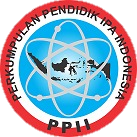ANALISIS KEMAMPUAN TIGA LEVEL REPRESENTASI SISWA PADA KONSEP ASAM-BASA MENGGUNAKAN KERANGKA DAC (DEFINITION, ALGORITHMIC, CONCEPTUAL)
DOI:
https://doi.org/10.15575/jtk.v3i2.3660Keywords:
kemampuan representasi kimia, kerangka DAC, konsep asam-basa.Abstract
Telah dilakukan penelitian yang ditujukan untuk menganalisis kemampuan tiga level representasi kimia pada konsep asam basa dengan menggunakan tes essay yang mengacu kepada kerangka DAC (Definition, Algorithmic Conceptual). Penelitian dilakukan terhadap 48 orang siswa sekolah menengah atas di wilayah Bandung. Indikator kemampuan representasi yang dianalisis mencakup kemampuan siswa dalam menghubungkan representasi simbolik ke submikroskopik, makroskopik ke simbolik, makroskopik ke submikroskopik dan simbolik serta makroskopik ke submikroskopik. Hasil penelitian menunjukkan secara keseluruhan siswa lebih berhasil merepresentasikan makroskopik ke submikroskopik dibandingkan dengan kemampuan representasi lainnya. Namun teridentifikasi potensi miskonsepsi pada sebagian besar siswa adalah mengenai konsep kekuatan asam-basa dan pH. Pencapaian terendah pada kemampuan representasi makroskopik ke simbolik yaitu pada penyelesaian soal yang membutuhkan langkah-langkah pengerjaan secara matematis dan melibatkan rumus atau perhitungan yang beragam (type A-Mu: Alghoritmic Multistep).
References
Amry, U. W., Rahayu, S., & Yahmin. (2017). Analisis Miskonsepsi Asam Basa Pada Pembelajaran Konvensional dan Dual Situated learning (DSLM ). Jurnal Pendidikan Teori, Penelitian Dan Pengembangan, 2(3), 385–391. https://doi.org/10.17977/jptpp.v2i3.8636
Bayrak, B. K. (2013). Using Two-Tier Test to Identify Primary Students ’ Conceptual Understanding and Alternative Conceptions in Acid Base. Mevlana International Journal of Education (MIJE), 3(2), 19–26.
Bird, L. (2010). Performance in General Chemistry. Journal of Chemical Education, 87(5), 541–546.
Cartrette, D. P., & Mayo, P. M. (2011). Students ’ understanding of acids / bases in organic chemistry contexts. Chem. Educ. Res. Pract., 12, 29–39. https://doi.org/10.1039/C1RP90005F
Cetin-dindar, A., & Geban, O. (2011). Development of a three-tier test to assess high school students ’ understanding of acids and bases. Procedia - Social and Behavioral Sciences, 15, 600–604. https://doi.org/10.1016/j.sbspro.2011.03.147
Chandrasegaran, A. L., Treagust, D. F., & Mocerino, M. (2007). The development of a two-tier multiple-choice diagnostic instrument for evaluating secondary school students ’ ability to describe and explain chemical reactions using multiple levels of representation, 8(3), 293–307.
Cooper, M. M., Kouyoumdjian, H., & Underwood, S. M. (2016). Investigating Students’ Reasoning about Acid–Base Reactions. Journal of Chemical Education, 93(10), 1703–1712. https://doi.org/10.1021/acs.jchemed.6b00417
Dori, Y. J., & Hameiri, M. (2014). The ‘ Mole Environment ’ studyware : applying multidimensional analysis to quantitative chemistry problems. International Journal of Science Education, (September 2014), 37–41. https://doi.org/10.1080/0950069980200305
Drechsler, M., & Schmidt, H. (2005). Textbooks ’ and teachers ’ understanding of acid-base models used in chemistry teaching. Chemistry Education Research and Practice, 6(1), 19–35. https://doi.org/10.1039/B4RP90002B
Farida, I. (2017). Evaluasi Pembelajaran Berdasarkan Kurikulum Nasional. Bandung: PT Remaja Rosda Karya.
Farida, I., Hadiansah, Mahmud, & Munandar, A. (2017). Project-based teaching and learning design for internalization of environmental literacy with islamic values. Jurnal Pendidikan IPA Indonesia, 6(2), 277–284. https://doi.org/10.15294/jpii.v6i2.9452
Farida, I., Liliasari, L., Sopandi, W., & Widyantoro, D. H. (2017). A web-based model to enhance competency in the interconnection of multiple levels of representation for pre-service teachers. In Ideas for 21st Century Education (pp. 359–362). CRC Press. https://doi.org/10.1201/9781315166575-84
Farida, I., Liliasari, L., Widyantoro, D. H., & Sopandi, W. (2010). Representational Competence’s Profile of Pre-Service Chemistry Teachers in Chemical Problem Solving. In 4th International Seminar of Science Education, Bandung (Vol. 30).
Gilbert, T. R., Kirss, R. V, Foster, N., Bretz, S. L., & Davies, G. (2018). Chemistry:The Science in Context. (E. Fahlgren, Ed.) (Fifth Ed). Newyork: W.W Norton & Company. https://doi.org/LCCN 2016048998
Indriyani, P. (2013). Analisis Pemahaman Makroskopik, Mikroskopik, dan Simbolik Titrasi Asam-Basa Siswa Kelas XI IPA SMA serta Upaya Perbaikannya dengan Pendekatan Mikroskopik. Jurnal Pendidikan Sains, 1(2 (Juni)), 109–120.
Michalchik, V., Rosenquist, A., Kozma, R., Kreikemeier, P., & Schank, P. (2008). Visualization: Theory and Practice In Science Education. In J. K. Gilbert, M. Reiner, & M. Nakhleh (Eds.), Representational Resources for Constructing Shared Understandings in the High School Chemistry Classroom (pp. 233–282). London: Springer Science.
Ozmen, H., Demircioglu, G., & Coll, R. K. (2009). A comparative study of the effects of a concept mapping enhanced laboratory experience on turkish high school students _ understanding of acid-base chemistry. International Journal
Sheppard, K. (2006). High school students ’ understanding of titrations and related acid- base phenomena. Chemistry Education Research and Practice, 7(1), 32–45.
Shwartz, Y., Ben-Zvi, R., & Hofstein, A. (2006). The use of scientific literacy taxonomy for assessing the development of chemical literacy among high-school students. Chemistry Education Research and Practice, 7(4), 203. https://doi.org/10.1039/b6rp90011a
Smith, K. C., Nakhleh, M. B., & Lowery, S. (2010). An expanded framework for analyzing general chemistry exams. Chemistry Education Research and Practice, 11, 147–153. https://doi.org/10.1039/C005463C
Stoyanovich, C., Gandhi, A., & Flynn, A. B. (2015). Acid–Base Learning Outcomes for Students in an Introductory Organic Chemistry Course. Journal of Chemical Education, 92(2), 220–229. https://doi.org/10.1021/ed5003338
Downloads
Published
Issue
Section
License
Authors who publish with this journal agree to the following terms:
- Authors retain copyright and grant the journal right of first publication with the work simultaneously licensed under a  Creative Commons Attribution-ShareAlike that allows others to share the work with an acknowledgement of the work's authorship and initial publication in this journal.
- Authors are able to enter into separate, additional contractual arrangements for the non-exclusive distribution of the journal's published version of the work (e.g., post it to an institutional repository or publish it in a book), with an acknowledgement of its initial publication in this journal.
- Authors are permitted and encouraged to post their work online (e.g., in institutional repositories or on their website) prior to and during the submission process, as it can lead to productive exchanges, as well as earlier and greater citation of published work (See The Effect of Open Access).








